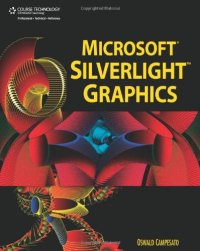
Ebook: Microsoft Silverlight Graphics
Author: Oswald Campesato
- Genre: Computers // Programming
- Year: 2008
- Publisher: Course Technology PTR
- Edition: 1
- Language: English
- pdf
This book offers concepts that are presented in a clear and logical manner. Instead of dumping code samples with limited and/or poor explanation, as I've seen other authors do, the author goes out of his way to explain everything, thereby saving me from having to spend my own time to figure out the code myself.
Compared to the Silverlight books that I purchased some months ago, this Silverlight book is unique for several reasons. First, this book has almost twice as much content as the other Silverlight books that I bought, including examples that do not exist in any of these (or other) Silverlight books.
Second, Oswald is obviously an expert in terms of vector-based graphics code (clearly shown in the SVG book that he has also authored) and his expertise is apparent in his Silverlight book as well.
Third, tihs book contains a chapter dedicated to explaining how to create, compile, and deploy Java servlets (which render Silverlight) in a web server, and he explains how to set up the open source servlet container Tomcat. There is also a chapter dedicated to charts/graphs, a chapter for scripting languages like IronPython, IronRuby, and a chapter for using scripting languages with Silverlight. All of these chapters are unique to this book.
I also discovered that almost all the code examples in the book work with both 1.0 and beta 2.0 version of Silverlight. The author does mention that some samples might not work with Silverlight beta 2.0, which suggests that his book went to press right around the time that Microsoft released Silverlight 2.0 beta.
The first part of the book provides useful information. For instance, the author clearly explains the rationale for using four files for Silverlight apps as it minimizes the impact on your code if/when Microsoft updates the Silverlight.js file.
Silverlight is a technology from Microsoft which is not just for Microsoft developers or tools. This books helps leverage this technology using non-Microsoft tools which in my opinion is a big plus. Why else would Microsoft make Silverlight a cross-browser plug-in? Unfortunately, none of the other Silverlight books that I bought describe the tools that are available for people who do not work on Windows or Visual Studio.
This book is like a "bridge" for non-Microsoft developers, especially for SVG developers, who will get a detailed comparison between SVG and Silverlight. This book is clearly beneficial for Microsoft's Silverlight strategy.
The bottom line is simple: Oswald's book is a very big plus for non-MS developers and for those interested in making rich graphics applications like myself to create applications in Silverlight. So, buying his book was the superior choice for me and I'm very pleased with my purchase.
Compared to the Silverlight books that I purchased some months ago, this Silverlight book is unique for several reasons. First, this book has almost twice as much content as the other Silverlight books that I bought, including examples that do not exist in any of these (or other) Silverlight books.
Second, Oswald is obviously an expert in terms of vector-based graphics code (clearly shown in the SVG book that he has also authored) and his expertise is apparent in his Silverlight book as well.
Third, tihs book contains a chapter dedicated to explaining how to create, compile, and deploy Java servlets (which render Silverlight) in a web server, and he explains how to set up the open source servlet container Tomcat. There is also a chapter dedicated to charts/graphs, a chapter for scripting languages like IronPython, IronRuby, and a chapter for using scripting languages with Silverlight. All of these chapters are unique to this book.
I also discovered that almost all the code examples in the book work with both 1.0 and beta 2.0 version of Silverlight. The author does mention that some samples might not work with Silverlight beta 2.0, which suggests that his book went to press right around the time that Microsoft released Silverlight 2.0 beta.
The first part of the book provides useful information. For instance, the author clearly explains the rationale for using four files for Silverlight apps as it minimizes the impact on your code if/when Microsoft updates the Silverlight.js file.
Silverlight is a technology from Microsoft which is not just for Microsoft developers or tools. This books helps leverage this technology using non-Microsoft tools which in my opinion is a big plus. Why else would Microsoft make Silverlight a cross-browser plug-in? Unfortunately, none of the other Silverlight books that I bought describe the tools that are available for people who do not work on Windows or Visual Studio.
This book is like a "bridge" for non-Microsoft developers, especially for SVG developers, who will get a detailed comparison between SVG and Silverlight. This book is clearly beneficial for Microsoft's Silverlight strategy.
The bottom line is simple: Oswald's book is a very big plus for non-MS developers and for those interested in making rich graphics applications like myself to create applications in Silverlight. So, buying his book was the superior choice for me and I'm very pleased with my purchase.
Download the book Microsoft Silverlight Graphics for free or read online
Continue reading on any device:

Last viewed books
Related books
{related-news}
Comments (0)